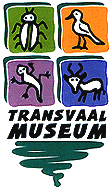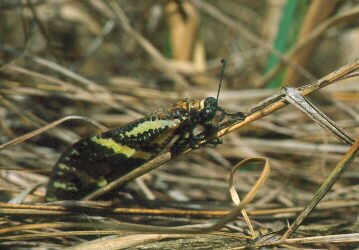
E - MAIL
Collection manager (Invertebrates)
Albert Makubung
Preparator
LINKS
Visit the site dedicated
to the locally infamous
Entomology Links
Department of Invertebrates
General Enthomology Collection
Order NEUROPTERA
(Lacewings / Antlions / Dobsonflies / Alderflies / Snakeflies)
The name Neuroptera is derived from the Greek word "neuron" meaning sinew and "ptera" meaning wings. The modern English translation "nerve-wings" is appropriate because it alludes to the extensive branching found in the wing veins of most Neuroptera.
Ant lion adult
Families in South Africa
-
- Coniopterygidae (dusty lacewings)
- Berothidae
- Rhachiberothidae
- Sisyridae (spongeflies)
- Dilaridae
- Osmylidae
- Mantispidae (mantisflies)
- Psychopsidae (silky lacewings)
- Hemerobiidae (brown lacewings)
- Chrysopidae (green lacewings)
- Nemopteridae (Spoon-, ribbon- and thread-winged lacewings)
- Ascalaphidae (owlflies)
- Myrmeleontidae (antlions)
The order Neuroptera includes the lacewings and antlions (suborder Planipennia), dobsonflies and alderflies (suborder Megaloptera) and snakeflies (suborder Raphidoidea). "Splitters" prefer to assign each of these groups to a separate order (Neuroptera, Megaloptera, and Raphidioptera, respectively), based on differences in structure and development.The Megaloptera are always aquatic as immatures. They live under stones or submerged vegetation and feed on a variety of small aquatic organisms. Large species, often called hellgrammites, may require several years of growth to reach maturity. Adults usually remain near water, although they are attracted to lights at night. In most species, the adults live only a few days and rarely feed.
Except for larval spongillaflies (family Sisyridae) which feed on fresh-water sponges, all members of the suborders Planipennia and Raphidoidea are terrestrial. Antlion larvae live in the soil and construct pitfall traps to snare prey. Lacewing larvae are usually found in vegetation where they typically feed on aphids, mites, and scale insects. Snakefly larvae live in leaf litter or under bark and catch aphids or other soft-bodied prey. In most cases, the adults of these insects are also predators -- the non-predatory species usually feed on nectar, pollen, or honeydew.
At first glance the antlions (Myrmeleontidae) resemble dragonflies, but differ most conspicuously in having antennae with clublike tips. Neuroptera are medium-sized insects that have many-veined wings. The adults have chewing mouthparts and their antennae are usually long. Metamorphosis is complete, the life stages being the egg, larva, pupa and adult. The larvae of antlions and lacewings have specialized mouthparts with large, sickle-shaped mandibles and maxillae that interlock to form pincers. Once impaled on these pincers, a prey's body contents are sucked out through hollow food channels running between the adjacent surfaces of the mandibles and maxillae.
As adults, all neuropterans have two pairs of membranous wings with an extensive pattern of veins and crossveins. At rest, the wings are folded flat over the abdomen or held tent-like over the body. Most species are rather weak fliers.
